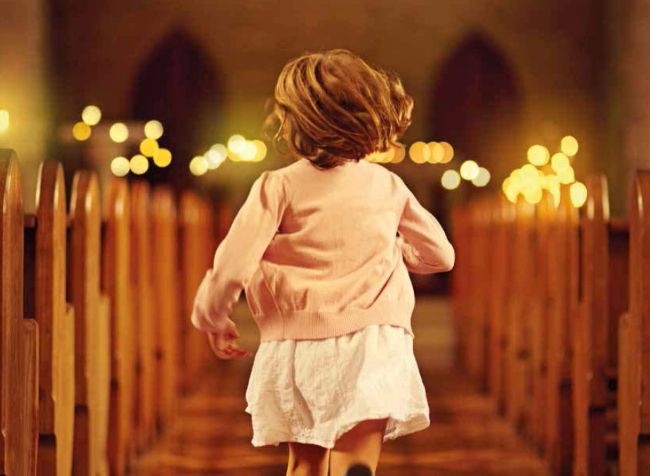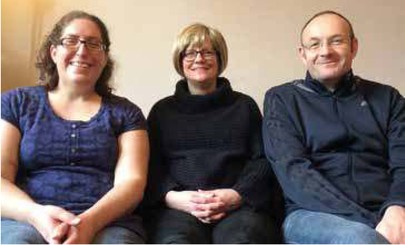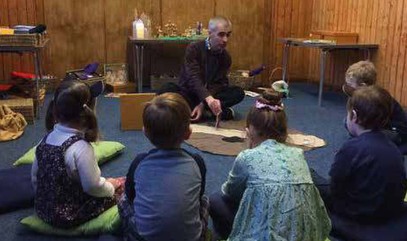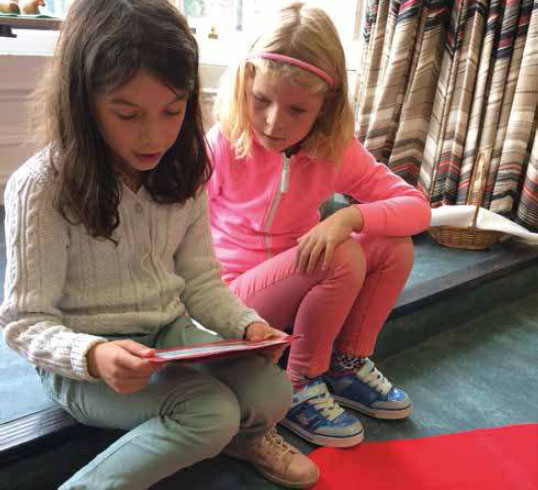Jackie Macadam learns about Godly Play, a different ap p roach to working with children in the Church.

Photo: iStock
AMONG the new expressions of Church there now seems to be something of a myriad of choices for the parents of young children.
Where once, church simply involved Sunday School for youngsters and perhaps a Bible Class for older children, now there are options such as Messy Church and Godly Play.
Whereas Messy Church speaks for itself, what is Godly Play and what does play have to do with Church?
Alex Mackenzie, a Godly Play trainer, who works with a small team of Godly Play advocates from the manse of Duddingston Kirk in Edinburgh, explains: “Godly Play is an approach to Church based on Montessori principles and the understanding that children discover and develop their own relationship with God for themselves. I’ve used Godly Play for longer than I’ve used any other single methodology for working with children and young people.
She adds: “The Godly Play teacher’s role is to support or help guide the person on that journey.”
“There are also elements of the ‘traditional’ church service about a Godly Play session, and like many activities aimed at children, it is fairly structured.”
Highlighting a typical session, she says: “Each session, or lesson, adopts the established pattern of worship from a greeting at the door, sharing God’s word in the form of a story, time to wonder about the meanings – both as a group and individually – the sharing of food, usually juice and a biscuit, and being sent back out into the world again.”
“It’s more fun to experience than to simply read!” says the rest of the Godly Play Team – Michelle Brown and Richard Knott, both training to be Godly Play trainers – a course that takes around 18 months to complete.
“Godly Play was created by Dr Jerome W Berryman, an American theologian, psychologist and teacher,” explains Alex.
“He had always been interested in children’s Christian education and at Princeton University in the early 1960s he found that the subject was rather dry. When querying it, he was told that if he wasn’t happy then it was up to him to do something about it…
“Ten years later, Berryman and his wife were training to become Montessori teachers. Due to Montessori’s own Christian faith there were already a number of religious Montessori materials, but Berryman saw how they could be adapted and began to develop them.
“He worked mainly in the Presbyterian tradition, with Sunday Schools, Saturday Clubs and as a pastor in a children’s hospital, trying out the stories and the method.

Left to right: Michelle Brown, Alex Mackenzie, Richard Knott
“His ideas caught on, and soon, people were coming to him to ask if they could do what he was doing. He became Canon Educator at Christ Church Cathedral in Houston and used the opportunity to set up Godly Play classrooms and began to produce the first real books of Godly Play stories for other people to use.
“Godly Play arrived in the UK in the 1990s and in 2010, Godly Play Scotland was founded.

Godly Play in action
“Last year, 2016, we had our first Scottish conference.”
Richard explains: “People can sometimes wonder how Godly Play and Messy Church differ – if they are ‘rival’ expressions, or if they can be used by the same church, but Godly Play and Messy Church are really two very distinct entities.”
He adds: “Godly Play is a method of engaging small groups, primarily written with children in mind and is a very reflective method of connecting and responding to God through words, visual materials and a variety of response options.
“Messy Church has a very different approach, involves a larger number of people and a wider range of ages coming together and being included.
“Godly Play would offer something for distinct age groups separately.
“In Messy Church the activities and responses are preplanned and those taking part make or do something that the facilitator has decided has some kind of link to the story being shared in the celebration and people are encouraged to work and to talk together while taking part. Godly Play offers a freedom for individuals to choose their response, a wide range of materials including those that we might think are unrelated to the story told at that session are also available at each session and participants are free to choose what they will work with or use as their response. In Godly Play anything created or worked on is not for any kind of ‘show and tell’ for the wider group but is rather seen as your individual response to God.”
Alex says “It’s fairly straightforward to set up a Godly Play space – or if you’re very blessed, a whole room!
“You need some of the storytelling materials but not all at the start. You can add them as you introduce a new story.
“Godly Play is an approach to Church based on Montessori principles and the understanding that children discover and develop their own relationship with God for themselves.

Children at Godly Play
One of the unique features of Godly Play is that the stories are told time and time again – so you are building a collection of resources, rather than doing something once and putting it in the bin afterwards. It’s also a good use of our fairly limited resources.
“One of the unique features of Godly Play is that the stories are told time and time again – so you are building a collection of resources, rather than doing something once and putting it in the bin afterwards. It’s also a good use of our fairly limited resources.
“A clear space to hold a Godly Play session is useful. You can often be working with fairly small groups, so sometimes a smaller, more intimate space works better. You don’t need tech of any kind. Some tables round the walls to put the stories and maybe some cushions on the floor works well for youngsters. If you’re working with older people, chairs are used instead.
“When I do a ‘Discovery Day’, when I introduce the idea of Godly Play to interested people, it generally takes me about 20 minutes to set it up properly.
“You do need the books, which have the stories, scripts and the movements. They’re not expensive and you can borrow them from us if you just want to try it out.
“The only other ‘big’ thing you need, and probably the easiest for those starting out, are the response materials. That’s the stuff that is used for their individual wondering. Things like felt tip pens, paper, some paints maybe, modelling clay and some books will give the full tactile experience.
“As the room or space develops, you’ll find people add all sorts of things that can be worked with.
“In the room here at Cramond, there are scraps of fabric, sewing things, wooden blocks, rubber bands, wool, a sand labyrinth, oil pastels, shells, matchsticks, cable ties mosaic tiles and just a whole lot of other materials that have been brought in. It’s an interesting variety of materials for children to choose from.
“There is also a good selection of Bibles, atlases, magazines and other books.
“The Cramond Godly Play room is a working room, used nearly every Sunday, and the Duddingston room is the main base for Godly Play Scotland, used for training, network meetings and as an example of how to set out and use a room.
“When I began doing Godly Play,” says Alex, “I didn’t have any materials and I didn’t tell a story, I began by adding the feast (the food element) and changing the space, but used the programme already in place. We sat round a few of the big church tables and the first thing I did was remove the tables. It took a while for the children to recover from that. They didn’t complain about the feast.
“Next, I took the chairs away and we sat on a rug on the floor. No one noticed, they were too busy complaining about the tables. At the same time I moved the craft to a separate table and let them choose what they wanted to do and choose their own space to do it in. Then I stopped providing a prescribed craft, I just had craft things and the children choose what they wanted to do from the ‘response’ tables. And then I told a story and we really haven’t stopped. They’ve finally forgotten about the tables. I have to add that for me to be confident enough with my storytelling,
I did do one of the three day Godly Play Storyteller and Door Person courses.
“For me, one of the important things is to have a programme and to know what I am doing. As you know more and more stories you find all the little phrases that go through them and it makes it much easier.”
A typical Godly Play session will include essential elements that give it the structured base it works from.
“There are also Going Deeper days where topics are explored more intensely and network meetings where people can get together and exchange ideas.
The Welcome – The Door Person welcomes you at the door and helps you hang up your coat, asks how you are and if you are ready to go into Godly Play.
Building the Circle – The Storyteller is already sitting on the floor in the Godly Play space, waiting to welcome you. You join the Circle on the floor. Once everyone has joined, the Storyteller helps you to Get Ready to enter into the story.
Story – It is told using special objects, maybe some wooden figures and sand or some felt and painted objects. Objects for telling other stories are all around you. The Storyteller wonders which story they will tell today and once they’ve found it, they bring it back to the circle.
Wondering – After the story, we wonder about the story through wonder questions the storyteller asks. Some people in the circle may wonder out loud and some may wonder silently. Both are welcomed as the circle reflects on the story we just heard and how we connect to it.
Response/Work – Each person in the circle has time to respond to the story through a variety of different mediums and materials. Some people may choose to work with the story they have just heard or any of the other stories, others may choose to use some of the art materials or may choose to read or to have some quiet time. The Storyteller stays in the circle and the Door Person helps with the practicalities for the response area.
Feast – After the response time, everyone is invited to come back to the circle to share in the feast. This is a small amount of food and drink shared around the circle with help from some participants in the circle. We wait until everyone has been served before we enjoy the feast.
Saying Goodbye – After the feast it is time to leave and the Storyteller and Door Person both say their goodbyes to you as you leave.
The team based at Duddingston covers the whole of Scotland, including the Islands. They help with training, taster sessions and running full three day storyteller and door person training courses. There are also Going Deeper days where topics are explored more intensely and network meetings where people can get together and exchange ideas.
Godly Play is also being used with other age groups, following the same principles as the sessions with children. It has proven useful with older teenagers, people with special needs, adults, even with people who have dementia.
“I have done a little Godly Play in care homes in Edinburgh, mostly supporting the work of the Rev Fran Ruthven, who was at Morningside United before she retired. The format is exactly the same as any other Godly Play session and, most importantly, the story is the same. The biggest difference is that people are in chairs, rather than on the floor.
“Godly Play also works well with children and adults with special needs. The structure and calmness, the lack of text (we aren’t reading a small print bible round the circle), the ability to choose a response that suits you and your abilities and the lack of pressure to have it ‘perfect’ for show and tell is liberating for some adults and children. Children with dyslexia aren’t put off by word searches and the need to be able to read, children on the Autism spectrum have the structure (and for some) the lack of eye contact with the storyteller helps them engage, for the child with ADHD the calmness of coming into the circle and structure helps them to engage,” says Alex. “We have a website and we welcome people to come and find out more. We’re all very approachable if you are interested in trying it out yourself.”
www.godlyplayscotland.co.uk